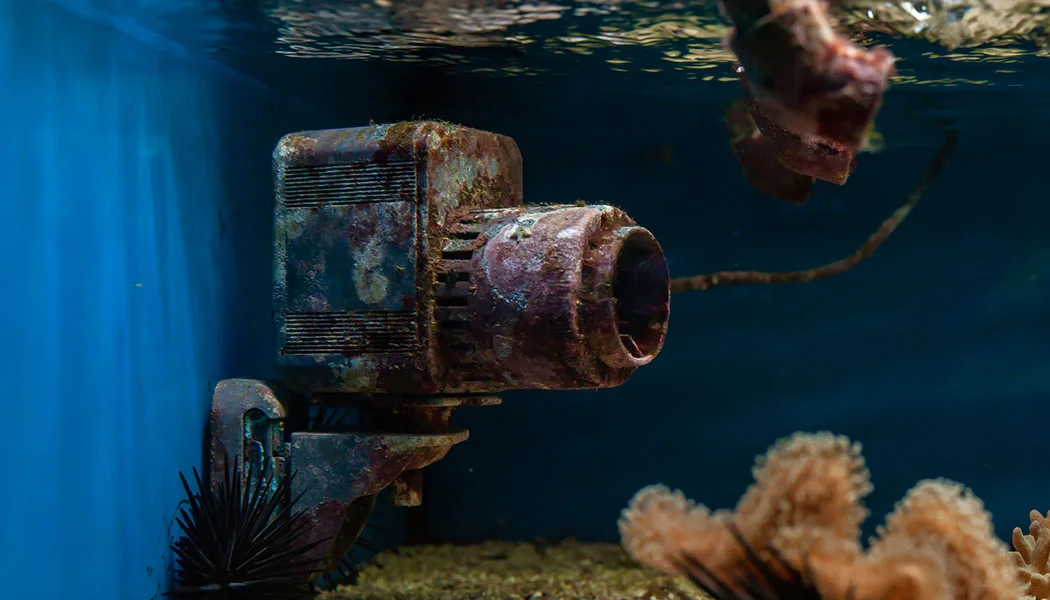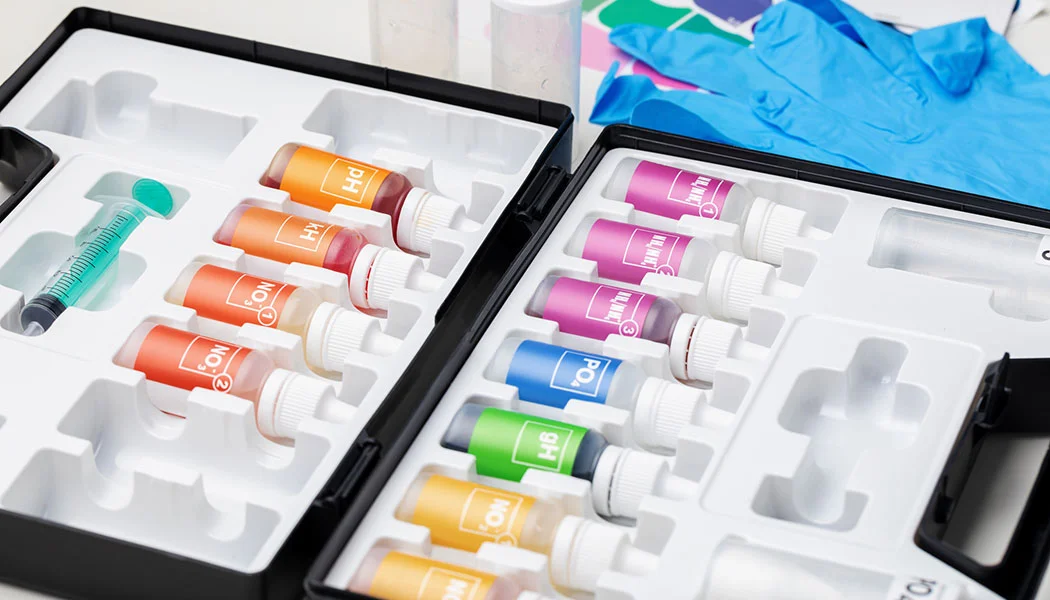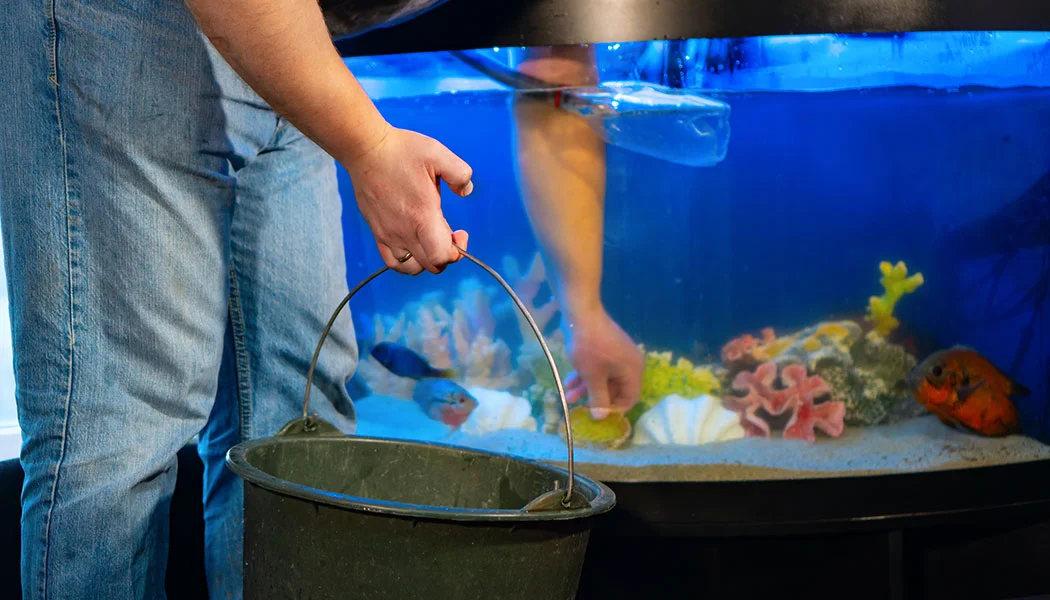You now have your saltwater aquarium set up and you have some fish, now comes the maintenance part. Saltwater aquarium maintenance doesn’t have to be a daunting task. When you break it up into smaller tasks per day, or week and keep to a schedule.
It’s not that bad.
When I first started my tank, it felt like it would take all day. Then you start getting the hang of it and develop some processes. Now it takes me less than an hour a week to maintain my tank. I’m going to talk about a typical maintenance schedule for daily, monthly, and yearly tasks.
Table of Contents
Key Takeaways
- Water changes are essential for maintaining stable water chemistry and preventing toxin buildup.
- Daily observations of fish and coral behavior help detect early signs of stress or illness.
- Regular equipment checks ensure that all filtrations and temperature control are functioning properly.
- Weekly water testing allows for the early detection of imbalances in key parameters like pH, ammonia, nitrite, and nitrate.
- Equipment maintenance and cleaning of pumps and powerheads reduce the risk of equipment failure.
Saltwater Aquarium Maintenance Schedule

Maintaining a saltwater aquarium is crucial for health and longevity. Unlike freshwater tanks, saltwater environments require more precise control over water parameters.
Regular maintenance ensures that these conditions remain stable.
Using an app like Aquarimate will help you maintain a consistent schedule.
The key aspect of maintenance is managing waste products in the tank. Fish produce ammonia, which can be toxic if allowed to accumulate. Through biological filtration and regular water changes, these toxins are broken down and removed. Without maintenance, harmful substances can build up. This will decline in water quality and cause the tank to crash.
Doing daily checks allows you to catch any issues early. Such as equipment malfunctions, discoloration in corals, or changes in fish behavior. Consistent maintenance also reduces the likelihood of major problems.
Essential Equipment for Saltwater Aquarium Maintenance
To successfully maintain a saltwater aquarium, you need good biological and mechanical filtration. This helps create and maintain the ideal environment for marine life.
Key pieces of equipment include:
- Live Rock: Acts as a natural biological filter by hosting beneficial nitrifying bacteria. This will break down ammonia and nitrites into less harmful substances.
- Protein Skimmers: Remove organic waste from the water before it breaks down into harmful substances.
- Water Test Kit: Essential for monitoring key water parameters. This should include pH, ammonia, nitrite, nitrate, and phosphate.
- Refractometer: Provides accurate measurements of salinity and specific gravity.
Investing in high-quality equipment. Sometimes it might be tempting to go cheap but doing this could results in spending more later.
The Nitrogen Cycle in Saltwater Aquariums
The nitrogen cycle is a process in any aquarium. This cycle converts toxic waste products into less harmful substances. Fish and other organisms produce waste, which breaks down into ammonia. Ammonia is a highly toxic compound comprised of two components: un-ionized ammonia (NH3) and ionized ammonia (NH4+). Your established beneficial bacteria then convert ammonia into nitrite. Nitrate is also toxic to fish which then converts to nitrate. Nitrate is the least harmful toxin of the three but still needs to be monitored.
The nitrogen cycle involves three stages:
| Process | Description |
|---|---|
| Ammonia to Nitrite | Bacteria called Nitrosomonas convert ammonia into nitrite. |
| Nitrite to Nitrate | Nitrobacter bacteria convert nitrite into nitrate. |
| Nitrate Removal | Nitrate is removed through water changes or absorbed by plants and algae. |
Source: Florida Department of Agriculture and Consumer Services. Aquarium Water Quality: Nitrogen Cycle.
Checklist for Regular Saltwater Fish Tank Maintenance

Consistent water changes help stabilize your water chemistry. This makes it easier to maintain the proper water parameters for your marine life. Water changes remove waste and replenish it with clean saltwater. Water changes can prevent common problems like algae blooms and imbalanced parameters.
A water change is the most effective way to address a lot of issues.
Daily Maintenance
- Observing Fish and Coral Behavior: Each day, take a moment to observe the fish and corals in your aquarium. Look for any changes in behavior, color, or signs of stress. Watch for issues like lethargy, unusual swimming patterns, or coral bleaching. Noticing these early can prevent more serious problems.
- Monitor Water Temperature and Salinity: Check the water temperature and salinity levels daily using a reliable thermometer, refractometer, or controller.
- Equipment Functionality Check: Ensure all equipment, including heaters, filters, lights, and protein skimmers are functioning properly.
Weekly Maintenance
- Water Change: Perform a 10% water change to help maintain stable water chemistry. Use mixed reverse osmosis water to replace the old water. It’s best to match the new water to the current temperature and salinity of your tank. Regular water changes can also replenish essential trace elements that can go unnoticed. Like Iodine, Potassium, and Iron. And as we know it removes excess nutrients that can lead to algae growth.
- Water Parameter Testing: Use a water test kit to check pH, ammonia, nitrite, nitrate, phosphate, and salinity levels. Regular testing of your water chemistry will help you take your next steps in adjustments. If you area adding corals to your aquarium, it is also recommended to test calcium, alkalinity, and magnesium on a weekly basis.
- Adjusting Water Parameters: Based on your test results, make any necessary adjustments. This might involve adding supplements or adjusting your saltwater mix.
- Cleaning Glass and Substrate: Algae buildup on the glass can obstruct your view. Clean the glass weekly using an aquarium-safe scraper or magnet cleaner. Vacuuming the substrate to remove debris and waste will help control nuisance algae.
Monthly Maintenance
- Cleaning Pumps and Powerheads: Take the time to clean your pumps and powerheads. These devices are prone to collecting debris, which can reduce their efficiency. Disassemble them and remove any buildup to ensure optimal water circulation in your tank. Use a toothbrush and white vinegar to help break up the junk. You can also use Citric Acid, which works better than vinegar. ⚠️ Always wear gloves and ear protection when handling citric acid.
- Siphoning Detritus Out of Sump: Over time, detritus can accumulate in your sump. This can lead to nutrient buildup and potentially harmful conditions. Siphon out this detritus monthly to maintain the cleanliness of your filtration system.
Saltwater Tank Chemistry Properties

Maintaining the correct chemistry in a saltwater aquarium is the most important element. Key parameters such as pH, ammonia, nitrite, nitrate, phosphate, salinity, calcium, alkalinity, and magnesium must be kept within specific ranges to support marine life.
It’s good to spend some time and understand how to monitor and adjust these parameters. Then you know what time of action to take when something is off.
Saltwater Parameters
The recommended ranges for key parameters are as follows:
| Parameter | Recommended Range |
|---|---|
| pH | 8.1 – 8.4 |
| Ammonia | 0 ppm |
| Nitrite | 0 ppm |
| Nitrate | 0 – 20 ppm |
| Phosphate | 0.03 – 0.1 ppm |
| Salinity | 1.023 – 1.026 (specific gravity) |
| Calcium | 400 – 450 ppm |
| Alkalinity | 8 – 12 dKH |
| Magnesium | 1250 – 1350 ppm |
Source: National Oceanic and Atmospheric Administration (NOAA). (2013). Small Scale Experimental Systems for Coral Research: Considerations, Planning, and Recommendations.
How to Adjust Saltwater Parameters
- Adjusting pH: If your pH is too low, use a buffer solution designed for saltwater aquariums to raise it. Add the buffer gradually, monitoring the pH after each addition. If the pH is too high, it’s often best to allow it to stabilize naturally, as rapid changes can stress your marine life.
- Adjusting Salinity: To raise salinity, add small amounts of pre-mixed saltwater to your tank. To lower it, remove a portion of the tank water and replace it with fresh RO/DI water. Use a refractometer to ensure the salinity is within the recommended range.
- Lowering Ammonia Levels: Ammonia can be toxic to marine life even at low levels. If detected, perform an immediate water change to dilute ammonia concentrations. Make sure your biological filtration is functioning properly. There should be enough beneficial bacteria to convert ammonia into less harmful substances.
- Lowering Nitrite Levels: Nitrite is harmful to marine life and should be kept at undetectable levels. To reduce nitrite, perform water changes to dilute it. Check if there is enough oxygen in the water.
- Lowering Nitrate Levels: High nitrate levels can lead to stress in marine life and promote algae growth. To reduce nitrate, conduct regular water changes to dilute. Consider using nitrate-reducing media or incorporating live plants or macroalgae. These will absorb nitrates from the water.
- Lowering Phosphates: Phosphates are a primary nutrient for algae. To reduce phosphate levels avoid overfeeding and use phosphate removing media. Regular water changes with RO/DI water can also help control phosphate levels.
When adjusting your Alkalinity, Calcium, and Magnesium, you can use Dr. Randy Holmes-Farley’s Reef Chemistry Calculator. This online tool will give you the exact amounts to adjust.
- Adjusting Alkalinity: To increase alkalinity, add a buffer that contains carbonate or bicarbonate. Monitor the alkalinity after each addition to avoid overcorrecting. If the alkalinity is too high, allow it to naturally decrease through regular water changes. Try not to raise more than 1 dKH per day.
- Adjusting Calcium: If calcium levels are low, add a calcium supplement designed for saltwater aquariums. Monitor calcium levels regularly to avoid overdosing. If levels are too high, allow them to naturally decrease and perform water changes. Try to only change around 20 ppm per day.
- Adjusting Magnesium: To increase magnesium levels, use a magnesium supplement. Like calcium, it should be added gradually and monitored closely. If magnesium is too high, it can usually be corrected with water changes. A safe range to raise magnesium per day is about 100 ppm.
⚠️ Make sure you change any saltwater parameter slowly. Adjusting these can take days. A quick change in any of these parameters could have negative effects on the livestock in your tank.
Frequently Asked Questions
Are Saltwater Fish Tanks Hard to Maintain?
Saltwater fish tanks require more attention and precision than freshwater tanks. Key factors include:
- Monitoring water parameters like salinity, pH, and temperature.
- Regular water changes to manage waste and toxins.
- Ensuring proper filtration and equipment function.
- Addressing algae growth and maintaining a clean environment.
How Often Should I Change the Water in a Saltwater Aquarium?
Perform a 10% water change to maintain water quality and stability.
How Often Should I Clean a Saltwater Aquarium?
It’s best to have a cleaning schedule for your aquarium. Most people do a weekly schedule that includes cleaning the glass, cleaning filtration, and dosing a 10% water change.
How Often Should I Test My Saltwater Aquarium Water?
You should test your aquarium water weekly. These are the recommended parameters and ranges to test for:
- pH: 8.1 – 8.4
- Ammonia: 0 ppm
- Nitrite: 0 ppm
- Nitrate: 0 – 20 ppm
- Phosphate: 0.03 – 0.1 ppm
- Salinity: 1.023 – 1.026 (specific gravity)
- Calcium: 400 – 450 ppm
- Alkalinity: 8 – 12 dKH
- Magnesium: 1250 – 1350 ppm
 Mixed Reef Tank
Mixed Reef Tank

